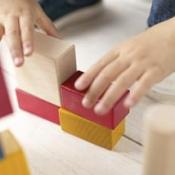 Play therapy has become a very important element of my work with families and children. In this article, I hope to give you parents some idea of how powerful play can be as an intervention as well as some ideas of how to utilize play with your own children.
Play therapy has become a very important element of my work with families and children. In this article, I hope to give you parents some idea of how powerful play can be as an intervention as well as some ideas of how to utilize play with your own children.
Play Therapy at Work
It is Father’s Day as I write this article and I am reminded of one particular case where play therapy had a profound impact on a family. This family had a child with severe autism. They were unable to manage him at home and he was living at the residential treatment facility where I worked. The child in question was very routine-oriented, and he had an extremely restricted range of activities in which he would engage. If he wasn’t repeatedly watching small snippets of Disney videos, he wasn’t happy.
To make matters worse, if he wasn’t happy, he tended to throw tantrums, or hit and bite those around him. As a result of these behaviors, not only could he not live at home, but the family was challenged to even have him home for short visits. They had to put the entire house on lockdown to prevent their son from wandering away, and at least one of them had to take time off of work to stay up all night to supervise their son.
When this child came onto my caseload, another therapist and I decided we wanted to work with the family to improve the quality of their interactions with their son and make their time together less stressful and challenging. We decided to use a therapy called Theraplay to accomplish this. We did several sessions with the child in which we exposed him to various new activities. We made note of what he liked, what he disliked, and what he just didn’t seem to get (but didn’t hate).
We expected to see a lot of behaviors due to the change in routine, but that wasn’t the case. We quickly found that there were a number of activities that the child seemed to enjoy. Furthermore, we found that a number of activities that he didn’t understand at first he learned and started to enjoy in subsequent sessions. Pretty soon, we had a list of about 20-or-so activities that required minimal material (about $20 of stuff from the dollar store) that he enjoyed. We could easily keep the child happily engaged for over 30 minutes at a time.
We then started doing sessions with the family at their house. First, they watched as we played with their son. Then we started showing them how to do the games. During the course of this session, we were demonstrating a modified version of catch. The child tended to want to catch the ball when thrown to him, but would then walk over and hand the ball back to us instead of throwing it. We learned that playing catch over a table got the child to actually throw the ball back.
As we were demonstrating this, he started throwing the ball to his dad and playing catch with him. Dad immediately started tearing up. He said, “This is the first time I’ve ever had a catch with my child.” There was not a dry eye in the room after that. What father doesn’t want to have a catch with his son? Imagine having to wait 17 years to make that happen. It was an unexpected, but awesome outcome of our therapy.
The Importance of Play in Development
Play is one of the fundamental ways in which children learn. Through play, they learn to how to connect or form secure attachments to others. The quality of the relationships children have growing up will impact the quality of the relationships they form as adults. So it stands to reason that good, quality play as a child can lead to quality relationships in adulthood.
Through play, children learn how to self-regulate. We get excited as we play games with each other, but then we learn how to self-calm and soothe to continue to excel at the games we play. We learn when it is appropriate to get excited and when we need to calm. In fact, I find that using play with children who have problems with regulation is a fantastic way to teach them impulse control and self-control.
Finally, through play, we learn how to socialize. We learn such things as taking turns, cooperation, and competition. We learn about rules and creativity. Through play we develop the basic skills that allow us to navigate the challenges that life presents us. Kids who don’t play are often at a great social disadvantage compared to kids who play.
Guidelines for Play
Ok, so play is important. However, the best play has some structure. To maximize the impact of play on your child’s behaviors, here are some basic guidelines to follow.
- Play with your child. When engaging in play, do things that involve interaction between you and your child. It’s not enough to simply be in the room (what I call proctoring). It’s great to sit with children as they do a puzzle, but it’s better to do the puzzle with them. You want to promote that social-emotional connection with you. You want to make yourself a source of never ending reinforcement in your child’s eyes. So, do activities that promote things like touch and eye contact (something the typical child with autism might be struggling with and need practice to do or tolerate). Make the time your child spends with you silly and fun; watch how your child positively responds to you in other situations.
- Keep it simple and developmentally appropriate. Make sure the activities you do with your child are geared towards their mental and emotional age. In the example at the beginning of the article, even though the child was 17, he enjoyed things like holding hands, rocking, and singing “Row Your Boat.” He enjoyed the sensory nature of the rocking, as well as the familiarity of the song. Other teenagers might enjoy singing and dancing with you to music they like. Again, focus on enhancing the connection between yourself and the child.
- It’s ok to be silly (in fact, it’s recommended)! The games I play with my kids (at home and at work) aren’t complicated. In fact, on the face of it they are pretty silly. I find that even with more resistant, morose children, silliness draws them in. There’s something about being silly with someone else that just brings down defenses. Besides, taking time to relax, laugh, and be a little silly is FUN! It’s a marvelous way to spend some time.
- Inexpensive is better! It’s very easy to spend a lot of money on toys. Heck, expensive toys can be great (I adore my Xbox). but for the types of interaction I’m thinking about, expensive toys are unnecessary. Blowing a feather back and forth, blowing bubbles, playing clapping games, or playing “red light, green light” require very little in the way of materials. Be creative and see what kinds of things are sitting around your house and look to those for inspiration. Have you ever seen a young child at Christmas? They open up all their expensive presents and spend most of the time playing with wrapping paper and boxes. Tap into that instinct with your child and you will be well on your way to successful play.
Ways to Use Play Therapeutically
Here are some more ideas on how to structure play sessions with your child to get specific results.
Planned sessions to increase engagement: While my usual play style is typically to improvise with whatever is at hand and make things up as I go along, I find that planning out sessions can be helpful when trying to engage with a child. I simply make a list of 5 to 10 activities that I want to do before I do the session and try to at least get through those. I make note of what activities seemed to get the child to respond positively to me so I can use them again later. If I don’t do this, I tend to more easily get shut down by the child if he/she doesn’t immediately engage with me. I focus on activities that promote touch, eye contact, and positive sensory experiences. Good examples are singing/clapping games, blowing up a balloon while the child holds the balloon, and blowing a feather back and forth between your hands and the child’s hands.
Repeated sessions to increase skills: If I am trying to help a child acquire or improve a skill, then I want to focus on repeating activities between sessions instead of changing things up frequently. Repeated exposure is good for skill acquisition. For example, I often use play to teach deep breathing through things like blowing bubbles, singing, and a game called “monkey ride” (in which I put a stuffed monkey on the child’s belly and then have him take a deep breath in and give the monkey a “ride” up to my hand which I place a couple of inches about the monkey’s head). I will repeat these games and variations of them through several sessions until the child has mastered belly breathing.
Short sessions for planned breaks from difficult tasks (The head cooler): When a child gets upset, frustrated, or anxious during specific situations, play can be a great way to manage this. For instance, a lot of my kids have problems around homework. They get upset if there’s too much, or if they don’t understand it. Some can’t make themselves take a break before the homework is complete. These children then get so upset they couldn’t do the work even if they wanted to. The poor parents are stuck not only trying to calm an upset child, but also facing daunting task of getting the child to return to finish the dreaded homework. Hours of this every night can be a major stressor for the whole family.
To counteract this, I suggest trying many short spurts. The parent works with the child to do homework, but also watches the child for the initial signs of agitation, frustration, or upset. As soon as the parent or child notices those signs, they take a short break. During the break, they spend just a few minutes doing something fun and silly (no video games or other major distractions). The goal of the activities is to allow the child’s head to “cool off.” Once calm, the child returns to the homework with a clear head. Families that have been successful in doing this find that not only are there fewer fights and tantrums around homework, but that more homework is getting done in less time.
The bottom line is that play is important. The more challenges you face with your child, the more important it is to put time aside every day to have some positive interactions. Be silly and have fun. Please share in the comments section your ideas for play or any questions you might have. In the meantime, play more with your kids and remember to BREATHE. You’ve got this!

The preceding article was solely written by the author named above. Any views and opinions expressed are not necessarily shared by GoodTherapy.org. Questions or concerns about the preceding article can be directed to the author or posted as a comment below.

 A Parent's Primer: The Power of Rewards
A Parent's Primer: The Power of Rewards Simple Really: Play is Beneficial for Children & Families
Simple Really: Play is Beneficial for Children & Families The Heart of a Play Therapist
The Heart of a Play Therapist

Please fill out all required fields to submit your message.
Invalid Email Address.
Please confirm that you are human.
Leave a Comment
By commenting you acknowledge acceptance of GoodTherapy.org's Terms and Conditions of Use.